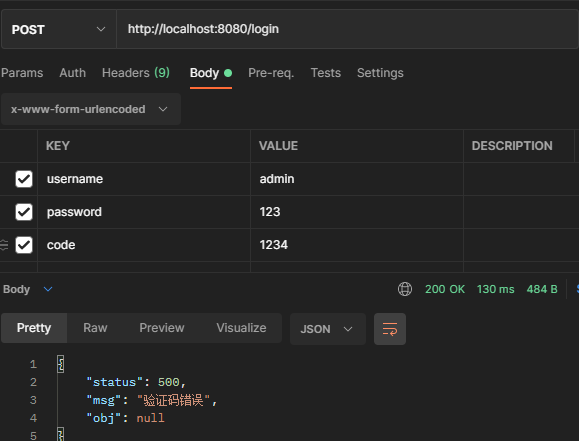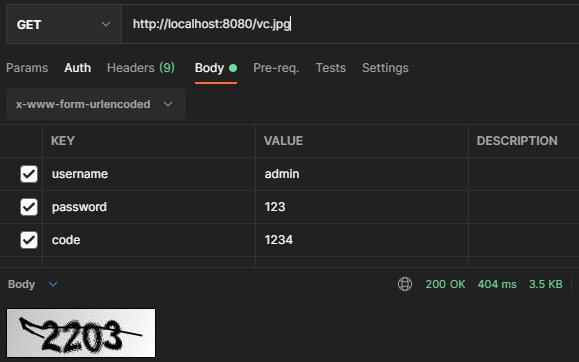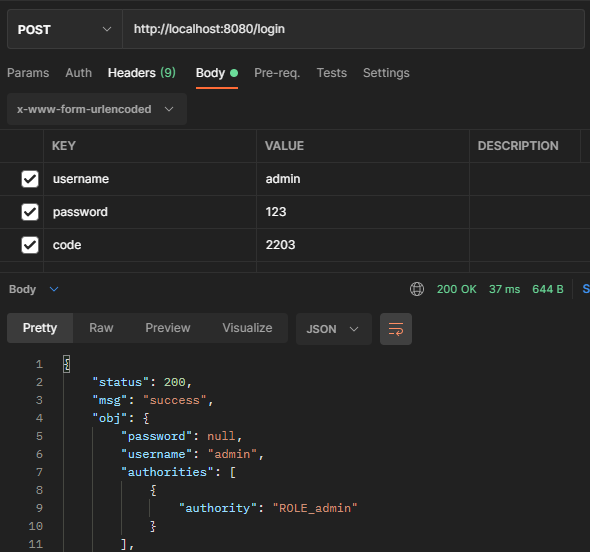n1cef1sh's Blog
练习代码同步到github:SpringSecuritySamples/verify_code
自定义认证逻辑——以验证码为例
SpringSecurity框架的核心机制就是过滤器链,具体原理暂且不研究,只知大概和使用方法。
这次要在之前登录功能的基础上,添加比较常见的登录验证码功能,设计思路如下
登录请求是调用 AbstractUserDetailsAuthenticationProvider#authenticate 方法进行认证的,在该方法中,又会调用到 DaoAuthenticationProvider#additionalAuthenticationChecks 方法做进一步的校验,去校验用户登录密码。我们可以自定义一个 AuthenticationProvider 代替 DaoAuthenticationProvider,并重写它里边的 additionalAuthenticationChecks 方法,在重写的过程中,加入验证码的校验逻辑即可。
这样的好处是不会破坏原来的过滤器链,并且完成了想要实现的自定义功能。
首先引入一个现成的验证码库kaptcha。
<dependency>
<groupId>com.github.penggle</groupId>
<artifactId>kaptcha</artifactId>
<version>2.3.2</version>
</dependency>
接着围绕验证码进行一系列设置,首先在SecurityConfig里提供一个验证码的实体类,设置验证码图片的基本属性
@Bean
DefaultKaptcha verifyCode() {
Properties properties = new Properties();
properties.setProperty("kaptcha.image.width", "150");
properties.setProperty("kaptcha.image.height", "50");
properties.setProperty("kaptcha.textproducer.char.string", "0123456789");
properties.setProperty("kaptcha.textproducer.char.length", "4");
Config config = new Config(properties);
DefaultKaptcha defaultKaptcha = new DefaultKaptcha();
defaultKaptcha.setConfig(config);
return defaultKaptcha;
}
编写返回验证码图片的接口
@RestController
public class VerifyCodeController {
@Autowired
Producer producer;
/**
* @Description: 返回验证码图片的接口
* @Param: [resp, session]
* @return: void
* @Date: 2021/4/2
*/
@GetMapping("/vc.jpg")
public void getVerifyCode(HttpServletResponse resp, HttpSession session) throws IOException {
resp.setContentType("image/jpeg");
String text = producer.createText();
session.setAttribute("verify_code", text);
BufferedImage image = producer.createImage(text);
try(ServletOutputStream out = resp.getOutputStream()) {
ImageIO.write(image, "jpg", out);
}
}
重点就是自定义一个MyAuthenticationProvider类,重写additionalAuthenticationChecks方法,从而在过滤器链中实现对验证码的验证功能
public class MyAuthenticationProvider extends DaoAuthenticationProvider {
@Override
protected void additionalAuthenticationChecks(UserDetails userDetails, UsernamePasswordAuthenticationToken authentication) throws AuthenticationException {
//获取当前请求
HttpServletRequest req = ((ServletRequestAttributes) RequestContextHolder.getRequestAttributes()).getRequest();
//拿到用户传来的验证码
String code = req.getParameter("code");
//session中拿到生成的验证码字符串
String verify_code = (String) req.getSession().getAttribute("verify_code");
//比较二者
if (code == null || verify_code == null || !code.equals(verify_code)) {
throw new AuthenticationServiceException("验证码错误");
}
//调用父类的这个方法,其中进行密码的校验
super.additionalAuthenticationChecks(userDetails, authentication);
}
}
但是只定义了没有用,所有的 AuthenticationProvider 都是放在 ProviderManager 中统一管理的,需要把自定义的MyAuthenticationProvider注入ProviderManager。
/**
* @Description: 提供自定义实例
* @Param: []
* @return: com.example.demo.config.MyAuthenticationProvider
* @Date: 2021/4/2
*/
@Bean
MyAuthenticationProvider myAuthenticationProvider() {
MyAuthenticationProvider myAuthenticationProvider = new MyAuthenticationProvider();
myAuthenticationProvider.setPasswordEncoder(passwordEncoder());
myAuthenticationProvider.setUserDetailsService(userDetailsService());
return myAuthenticationProvider;
}
/**
* @Description: 把自定义的myAuthenticationProvider注入ProviderManager
* @Param: []
* @return: org.springframework.security.authentication.AuthenticationManager
* @Date: 2021/4/2
*/
@Override
@Bean
protected AuthenticationManager authenticationManager() throws Exception {
ProviderManager manager = new ProviderManager(Arrays.asList(myAuthenticationProvider()));
return manager;
}
最后设置/vc.jpg所有人都可以访问,并且设置各种返回信息。
启动项目测试。
随便输一个验证码的话,提示错误

然后get到/vc.jpg查看验证码

输入正确的验证码登录

2021-11-15更新
关于登录用户详细信息
Authentication 接口用来保存我们的登录用户信息,是对java.security.Principal的进一步封装。这里使用其中的 getDetails接口,查看有关身份认证的其他信息,默认存储的是用户登录的ip和sessionId。
默认的配置是通过 WebAuthenticationDetailsSource 来构建 WebAuthenticationDetails,并将结果设置到 Authentication 的 details 属性中去。为了更方便的使用和拓展,可以自定义WebAuthenticationDetails实现功能。
首先定义一个MyWebAuthenticationDetails继承WebAuthenticationDetails。在这里面对验证码进行判断。
而拓展属性的话也在这里增加,然后从 HttpServletRequest 中提取出来设置给对应的属性即可。此处随便定义了一个test拓展属性用来测试。
private boolean isPassed;
//拓展属性,测试用
private final String test;
public MyWebAuthenticationDetails(HttpServletRequest req) {
super(req);
this.test = req.getParameter("test");
String code = req.getParameter("code");
String verify_code = (String) req.getSession().getAttribute("verify_code");
if (code != null && verify_code != null && code.equals(verify_code)) {
isPassed = true;
}
}
public boolean isPassed() {
return isPassed;
}
public String getTest(){
return test;
}
然后在自定义的MyWebAuthenticationDetailsSource里构造MyWebAuthenticationDetails
@Component
public class MyWebAuthenticationDetailsSource implements AuthenticationDetailsSource<HttpServletRequest,MyWebAuthenticationDetails> {
@Override
public MyWebAuthenticationDetails buildDetails(HttpServletRequest httpServletRequest) {
return new MyWebAuthenticationDetails(httpServletRequest);
}
}
定义好之后,就可以在之前的MyAuthenticationProvider里进行调用判断了。
public class MyAuthenticationProvider extends DaoAuthenticationProvider {
@Override
protected void additionalAuthenticationChecks(UserDetails userDetails, UsernamePasswordAuthenticationToken authentication) throws AuthenticationException {
if (!((MyWebAuthenticationDetails) authentication.getDetails()).isPassed()) {
throw new AuthenticationServiceException("验证码错误");
}
super.additionalAuthenticationChecks(userDetails, authentication);
}
}
最后就是修改配置类,用自定义的MyWebAuthenticationDetailsSource 代替系统默认的WebAuthenticationDetailsSource。
@Autowired
MyWebAuthenticationDetailsSource myWebAuthenticationDetailsSource;
@Override
protected void configure(HttpSecurity http) throws Exception {
http.authorizeRequests()
...
.and()
.formLogin()
//新增了这行,配置了注入的myWebAuthenticationDetailsSource
.authenticationDetailsSource(myWebAuthenticationDetailsSource)
...
}
完成配置后,在service里去获取detail。之所以在service里操作,就是为了体现随时随地的特点。
@Service
public class HelloService {
public void hello() {
Authentication authentication = SecurityContextHolder.getContext().getAuthentication();
MyWebAuthenticationDetails details = (MyWebAuthenticationDetails) authentication.getDetails();
System.out.println(details);
}
}
最后在controller的接口里调用service,访问接口,查看控制台输入,打印了登录用户的ip和sessionid,但是没有打印出自己新加的拓展属性。

看了一下WebAuthenticationDetails的源码,问题出在这里。有一个默认的toString方法。
public String toString() {
StringBuilder sb = new StringBuilder();
sb.append(this.getClass().getSimpleName()).append(" [");
sb.append("RemoteIpAddress=").append(this.getRemoteAddress()).append(", ");
sb.append("SessionId=").append(this.getSessionId()).append("]");
return sb.toString();
}
所以只要在MyWebAuthenticationDetails里重写一下这个方法,把test加上就行了。
@Override
public String toString() {
StringBuilder sb = new StringBuilder();
sb.append(this.getClass().getSimpleName()).append(" [");
sb.append("RemoteIpAddress=").append(this.getRemoteAddress()).append(", ");
sb.append("SessionId=").append(this.getSessionId()).append(", ");
sb.append("Test=").append(this.getTest()).append("]");
return sb.toString();
}
再访问接口,查看控制台输出就可以了。
